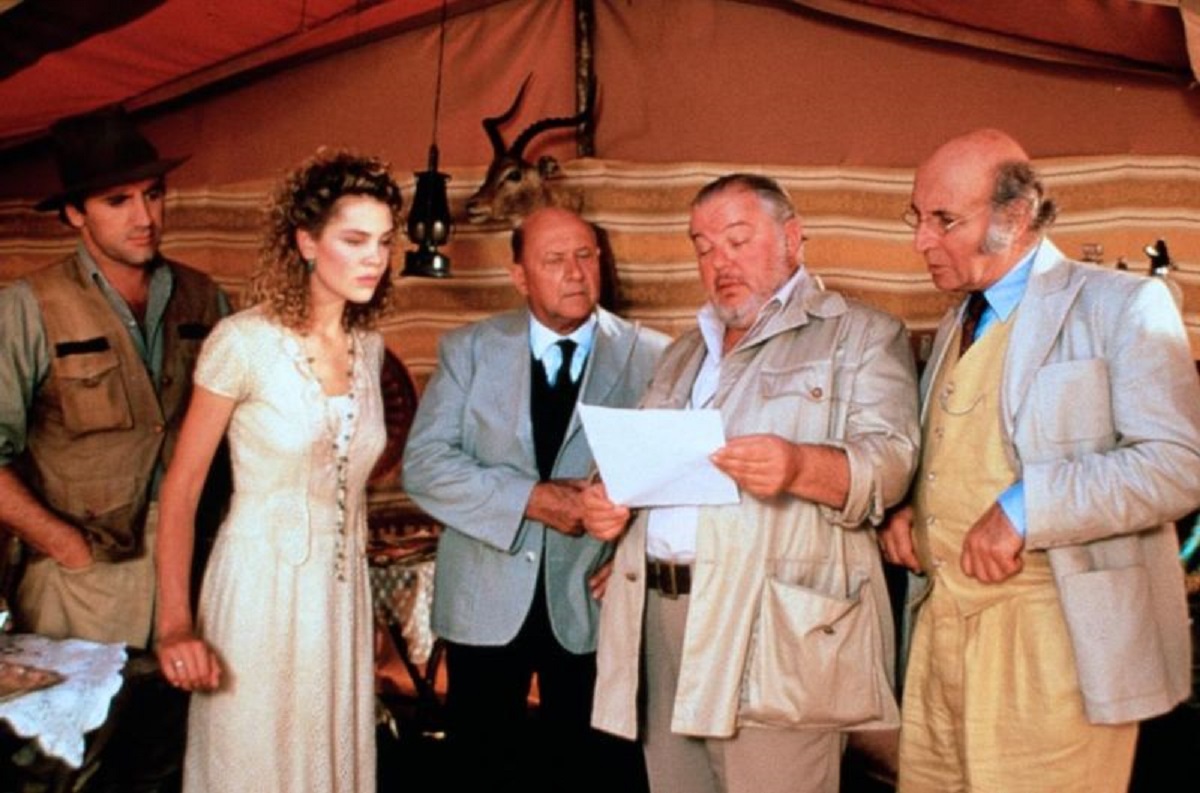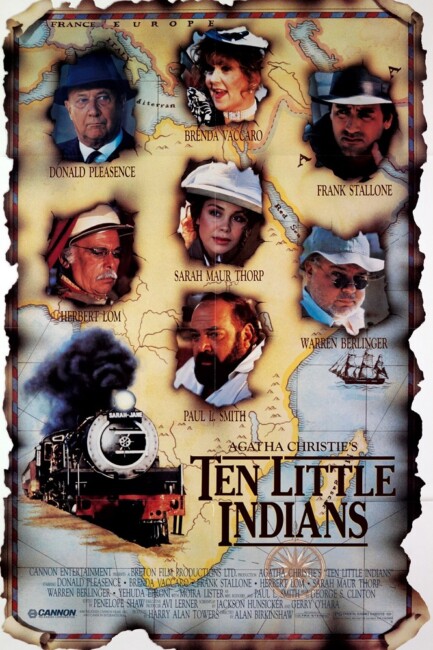aka Death on Safari
UK. 1989.
Crew
Director – Alan Birkinshaw, Screenplay – Jackson Hunsicker & Gerry O’Hara, Based on the Play/Novel Ten Little Indians (1939) by Agatha Christie, Producer – Harry Alan Towers, Photography – Arthur Lavis, Music – George S. Clinton, Art Direction – George Canes. Production Company – Breton Films Productions Ltd..
Cast
Donald Pleasance (Judge Lawrence Wargrave), Frank Stallone (Captain Philip Lombard), Sarah Maur Thorp (Vera Claythorne), Yehuda Efroni (Dr. Hans Werner), Herbert Lom (General Brancko Romensky), Paul L. Smith (Elmo Rodgers), Brenda Vaccaro (Marion Marshall), Warren Berlinger (Mr. Blore), Neil McCarthy (Anthony Marston), Moira Lister (Ethel Mae Rodgers)
Plot
The 1930s. A group of ten people from different countries and walks of life are brought together, having either been invited or hired to work on a safari in the African wilderness. Their host, the mysterious U.N. Owen, is absent. The group are taken to a mesa accessible only by a rope gondolier, which is then cut by the native bearers abandoning them there. As the group settle in to their tent encampment, a gramophone record is found left by U.N. Owen, which announces that they are all guilty of murder. As the festivities begin, various of the group begin to be murdered.
Agatha Christie (1890-1976) was one of the most popular authors of all time. Nicknamed The Queen of Crime, Christie specialised in murder mysteries – she patented a formula where a murder usually took place at a locale and offered up a variety of suspects, each with good reason to be the killer, before their identity would be revealed in the last chapter. She began publishing with the novel The Mysterious Affair at Styles (1920), which introduced her most famous character, the detective Hercule Poirot. During her lifetime, she produced 66 novels, including Murder on the Orient Express (1934), Death on the Nile (1937), Appointment with Death (1938), Evil Under the Sun (1941), Sparkling Cyanide (1945) and The Mirror Crack’d (1962), among many others. Christie’s works have been adapted to the screen on numerous occasions, most famously with the hit Murder on the Orient Express (1974), which led to a spate of big-budget adaptations, and the success enjoyed by the tv series’ Miss Marple (1984-92) and Poirot (1989-2013). More recently, she underwent a revival with Kenneth Branagh’s remake of Murder on the Orient Express (2017), which was followed by sequels and a host of British tv adaptations.
This is a film based on the Christie book that was originally published under the title Ten Little Niggers (1939), a title taken from a children’s rhyme. Not too surprisingly, that title has been dropped these days – subsequent reprintings substituted Ten Little Indians, while in the US printing it was changed to And Then There Were None and that seems to have stuck as the least offensive title. This purportedly has been the best-selling of all of Christie’s books. Christie also wrote a stage adaptation Ten Little Niggers (1943).
The story has been adapted to the screen a number of times beginning with And Then There Were None (1945). Other versions include the likes of Ten Little Indians (1965), the all-star And Then There Were None (1974), a Russian version Ten Little Indians (1987), the BBC mini-series And Then There Were None (2015) and the French mini-series They Were Ten (2020). There was even a Bollywood version Gumnaam (1965). Hideo Nakata’s Incite Mill (2010) was made as a homage, while Mario Bava drew on the basic plot for his giallo film Twitch of the Death Nerve (1971), which was a prototypical influence on the slasher film.
This version was made by British producer Harry Alan Towers (1920-2009), who had a long history with genre material including the Christopher Lee Fu Manchu films and several collaborations with Jesus Franco. Towers owned the rights to the Agatha Christie novel and also produced both the 1965 and 1974 adaptations. It should be noted that Towers shot Ten Little Indians in South Africa at a time when most of the world was maintaining sanctions against the country over the apartheid system. The film was picked up for release by Cannon Films, just at the time when they declared bankruptcy.

Here the Agatha Christie story has been uprooted from its original island setting and transplanted to a safari in an unspecified African country. To get the characters isolated, the set-up takes them to a mesa where a tent camp has been set up, with the native bearers cutting the rope gondola back. The African setting certainly adds some colour, even if it is a colonialist vision of Africa. That said, once the story settles into the camp, director Alan Birkinshaw displays zero interest in the pictorial value of the countryside. And for all the promise of “Agatha Christie on a safari”, the grounding of the film around the tents and an open-air dinnertable proves a let-down.
The characters are much more of an international mix than before. The failing of the script is that while all of the characters are called murderers and a number of them deny this or argue extenuating circumstances, the script seems uninterested in the crimes that each is accused of, at most devoting a line or two of dialogue to them. The other noticeable change is that this follows the 1945 film in having a handsome man and woman survive rather than everybody killed as in the book.
This is much more of a horror-minded version of the story, which is something I would like to see done properly. This aims somewhat in the general direction of a slasher take and we do get some gorier deaths than in any other version. On the other hand, Alan Birkinshaw is too shabby a director to make much out of any of this.
Amongst the cast there is nothing particularly standout about the performances. The surprise among these is Frank Stallone, Sylvester’s younger brother, whose attempts at an acting career have fairly much been regarded as a joke. Here though Stallone does quite a good job in slotting into the role of the white hunter.
Director Alan Birkinshaw, who is brother of celebrated British writer Fay Weldon, has made a number of other genre films including Killer’s Moon (1978) and Invaders of the Lost Gold/Horror Safari (1982), as well as uncredited additional scenes for the slasher Don’t Open Until Christmas (1984). For producer Harry Alan Towers, Birkinshaw made two modernised Edgar Allan Poe adaptation with The House of Usher (1989) and The Masque of the Red Death (1989).
Trailer here


